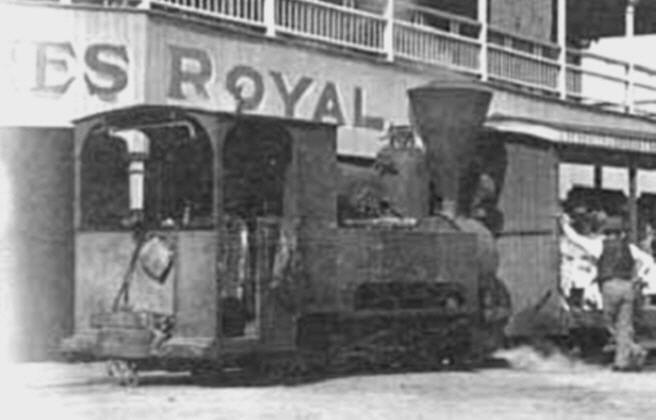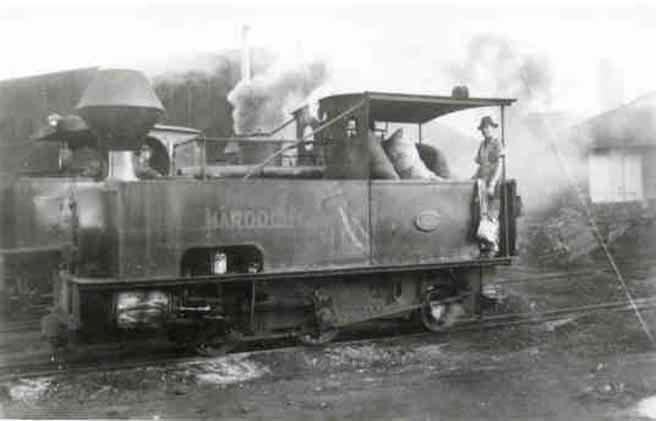
The
first Locomotives
As
sugarcane production in the Moreton Central area increased year by year, the
loads of cane became heavier and the rakes of trucks grew longer. Some form of
locomotive was needed to replace the horses, which could not manage the work.
Steam engines had been favoured by the Directors of the Mill from the
beginning, but in 1903 they requested a government engineer, Mr A. R.
Mackenzie, to act as a consultant for the Dulong Tramway and to provide expert
advice.
He
said that the internal combustion engine running on oil, kerosene or petrol
was a better and more modern alternative, and a locomotive so powered would be
much cheaper to operate than a steam locomotive. It needed only a driver,
whereas the steam engine required a driver and a fireman. He estimated
that whereas a steam loco would cost 52 shillings per day to operate, a
motor-powered loco could be run for only 16 shillings and sixpence, less than one third as much.
Another
factor in favour of internal combustion powered locomotives was that they
needed only fuel to operate. As well as burning coal or wood, steam engines had quite
an appetite for water. The Mill would be faced with the additional expense of
providing watering facilities around the tramway network if steam locos were
used, as they would of necessity be small engines, unable to carry a large supply
of water for extended running.
Mackenzie told the Company that he had personally designed a small internal combustion powered locomotive with four coupled wheels that would be ideal for their requirements. He termed it a 'motor' and suggested that the Company have one built in Brisbane. The building of 'motor locomotives' at that time was practically unknown anywhere, although different types were soon to be developed by various firms, so it is rather surprising that the Mill Manager took Mackenzie's advice and ordered such a locomotive in 1903.
An article describing the 'motor' and its arrival at the Moreton Mill appeared in The Chronicle of 7th August of that year, and this is the source (including verbatim quotes where the meaning is unclear) of the following information.
'The ideas of fittings' for the 'motor' were those of Mackenzie in collaboration with James Wilson of Elizabeth Street, Brisbane, who also made and installed them. From this we can assume that Mackenzie provided the basic design and specifications, and that Wilson manufactured the locomotive, using an off-the-shelf engine purchased locally as a powerplant. It is known that Wilson supplied at least one other 'motor' to a different sugar mill in 1910.
The Moreton 'motor' had a Tangye single-cylinder engine of eight horsepower that used White Rose kerosene as fuel. The piston had a diameter of 7 inches. It had two large flywheels and was purchased from the Engineering Supply Company of Australia (E.S.C.A.).
This engine was connected to a friction clutch and gearbox which allowed for the selection of two forward gears and a reverse gear.These gears were connected to the driving axle, which was connected to the other axle by means of coupling rods attached to the wheels, all four wheels thus being powered. It was fitted with track brakes, a handwhe
el and stand pressing brake blocks down against the rails, rather than against the wheel tires.
Attached
to this four-wheeled 'motor' was a 28 feet long 'trolley'. This 'trolley' had a bogie at one end, but the other was attached to the
'motor' by a 'kingbolt and two chafing pieces'. This created an articulated
vehicle in the manner of a semi-trailer or articulated truck, with half of the weight of the
load on the trolley being transferred to the 'motor' to assist adhesion.
While designed to carry different loads, its length indicates that the main
purpose of the trolley was to carry lengths of rail for tramway construction
between Highworth and Kureelpa.
The
published description in The Chronicle describes the vehicle somewhat ambiguously as having 'two bogies - the lay bogie and the power bogie, the latter carrying most of
the weight of the engine'. The report states that the bogie on the trolley
was fitted with an 'ordinary brake' (presumably using a hand crank to
press brake shoes against the bogie wheel tires, as with the braked cane
trucks and later the bogie vehicles used on the tramway).
Though
the Atlas Car performed useful work during permanent way construction in the
Kureelpa - Dulong area, by and large it was not a success. It was restricted
to light loads and would not have been very useful hauling cane - it would
have been struggling to lift two fully loaded cane trucks up Doig's Bank,
and probably could not have managed three. This was about the same as a team
of four horses could achieve. Its clutch plates burned out repeatedly, and it
had to be sent to Brisbane on occasion for repairs. In late 1903, when the
visit to the area by a reporter and photographer from the Queensland
Agricultural Journal took place (described here), they were disappointed
to find that the Atlas Car was not there. They wrote:
"We
had hoped to see the motor at work, but it had been sent to Brisbane for some
alteration to the clutches and had not been returned when we left."
After
a year the Atlas Car was dismantled and its engine used to drive the Mill's
electric lighting plant. It was soon found to be inadequate for that task too,
and a bigger lighting plant was installed, powered by a steam engine fed from
the Mill's boiler.
****************************
Other
sugar mills in Queensland were enthusiastically purchasing small steam
locomotives to haul their cane trains, so the Moreton Central Mill decided to
abandon internal combustion and follow suit. Being short of funds and still under Government control, they
purchased a small 0-6-0T side tank steam engine from the agent O. Granowski.
Built in 1901 by Krauss in Germany (B/N 4687), this engine had 91/4 inch x 12 inch cylinders, and 24 inch diameter wheels. It used Stephenson's outside link motion valve gear, the connecting rod and eccentrics of which were mounted on the third drivers. It was commissioned in July 1904 and named Moreton. This little locomotve proved very successful on the flat lands around the Mill, but could not negotiate the steep route up the Highworth Range which continued to be worked, together with some hilly sections of the Image Flat, Coe's Creek, Perwillowen and Paynter's Creek lines, by a roster of forty horses.

Moreton with an excursion in Mill Street, outside the Royal George Hotel. Photograph courtesy Sunshine Coast Libraries
The
Mill gradually increased its fleet of small locomotives over the years, the
engines being named after the various routes in the network. Maroochy,
an 0-4-2T, was purchased from Hudswell Clarke in 1914. In 1923 and 1925 two sister
0-6-0T locomotives were purchased from John Fowler's works in Leeds. These
were named Coolum and Eudlo.

Maroochy in the Mill yard, with the Shay behind.
Note the sacks of coal carried in the cab and the driver's water-bottle hitched
onto the cab rail.
Photograph courtesy Sunshine Coast Libraries
All of these engines are still in existence, although none is in working order. An exception of sorts is the Moreton, which still hauls trains on a daily basis, though not in steam. More information, and an album of 32 photographs from the John Browning Collection showing the locomotives during their working lives, is available here.
It
is an interesting fact that, as late as 1964, horses were still being
employed in the Mill yard for hauling cane trucks, but they were soon
replaced by a steam winch. The last three horses were pensioned off in 1965.